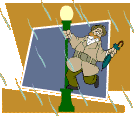 Logo handmade by Bannister
Column by Scott Green
Logo handmade by Bannister
Column by Scott Green
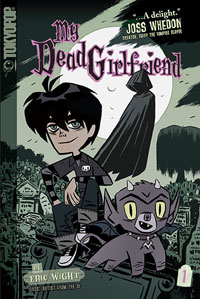
OEL Graphic Novel Spotlight: My Dead Girlfriend Volume 1: A Tryst of Fate By Eric Wight Released by TOKYOPOP
Given AICN's affection for pulp and exploitation, it's probably important to immediately establish that despite what the title might suggest, My Dead Girlfriend is neither. Instead, the unconventional style that Eric Wight employs and the book's bittersweet evocative tone complement each other to create a comic of credible emotions and deliberately incredible circumstances. More honest than a rote high concept meet-cute romance, My Dead Girlfriend is the right comic for Valentine’s Day regardless of whether you're in love, out love, or somewhere in-between. Set at the juncture between Halloweentown and American suburbia, Finney Bleak doesn't fit into with any group at school, where he is at odds with the likes of The Deadbeats (a clique of teen versions of various Universal horror icons) and the Aberzombie conformist nonconformists. At home, he feels that he doesn't relate to his cheery parents or his conjoined triplet older sisters. However, after meeting a girl named Jenny at a local fair, Finney allows himself to drop the defensive stance he habitually holds against the world during a day of happiness. Unfortunately, when it comes time for them to meet up again, she never arrives. Three months pass, and Finney begins to doubt he ever really met a girl named Jenny. Many of My Dead Girlfriend's key elements aren't unfamiliar. Alienated teen loners; unlikely lovers separated by identity and events; even the school populated by figures from horror is covered ground. If the series ending isn't the predictable one (the series will likely run the TOKYOPOP formula 3 graphic novel release), it will be quite shocking. But, in look and tone, Wight ensures that My Dead Girlfriend is not retread material. Wight quickly establishes a tragi-comic framework to My Dead Girl Friend. Protagonist Finney Bleak introduces his circumstances by suggesting that, at least to some degree, one's life is determined before birth. Children of athletes tend to be athletic; children of artists tend to be artistic; children of scholars tend to be intellectual. In Finney’s case, the Bleak family tends to die preposterous deaths. The point is illustrated with a depiction of the demise of Cornelius Archibald Bleak (1645-1698). The merchant sea captain was haunted by nightmares of being consumed by a shark, but ultimately, during a mutiny, he ends his life in a Rube Goldberg/Final Destination storm of bad luck, only capped off by the teeth of the shark. In one sense Cornelius Archibald Bleak is a ridiculous figure. Even before his mini-golf style curtain call, he looked plainly laughable: a stubby man with an oversized head, almost encased in period regalia who is kept from looking like a super-deformed caricature or a Jack Kirby alien by Wight's solid hash line style, which gives the work the flexibly to stretch its degree of exaggeration while maintaining a visual consistency. Yet, the captain's struggle to preserve his life, that he's not resigned to his fate and that he's really not happy about it are strong reminders that the character is supposed to be representing a human, and as such he was the protagonist of his own life's story. Wight takes a Woody Allen like approach to constructing these characters for whom an Acme anvil serves as a Sword of Damocles. The narrative and the manner of expression is conscious that most of the humorous moments in Finney's story are either embarrassing or social gallows humor, and as such are not funny to the character himself. It's the treatment of his exaggerated plague of misfortune that ensures that My Dead Girlfriend doesn't become shallow. The tag "emo" could probably be fairly applied to My Dead Girlfriend. Regardless of any potential disconnect between how objectively bad Finney's situations is and how bad he believes it to be, the comic is more overcast than strictly dour. Like the other reactions in the comic, the happiness introduced by Jenny feels honest. Because the circuit between the events and Finney's reaction and mood is allowed to flow naturally, the various conceits needed to establish a story like the comic's become grounded in emotional reality. While the work is narration-heavy, the voice is not overbearing. The degree to which Finney talks to himself isn't inordinate to the story, and doesn't unmanageablely bog down the flow. For a comic, Wight's writing has verbose tendencies. Because his page layouts do handle that characteristic gracefully, the quality doesn't greatly impact the visual nature of the comic. Unfortunately, attempts to be witty in condense amounts of space seem strained. Building to jokes in the conversations between multiple characters works well, with patterns of set up and delivery that are effective in comics. Short zingers such as "I like you too. Believe me. Like need a restraining order' alot" seem to require a degree of character voice inflection that is unavailable in a comic. The classification information on the back cover of My Dead Girlfriend lists "Manga: Comedy/Fantasy". Terminology debates aside, the potential of "world manga" or original English language manga or what-ever was supposed to be that it would generate compelling mixes of traditions. Well, if anyone has labored to formulate a grand, super-poylmer, it's apparently Wight. The resulting amalgam doesn't look like any one other style of work. Functionally, as a comic, this allows My Dead Girlfriends to overate on its own level . The iconic look of the characters, and their distinct sets of clothes suggests that the comic is working off a set of models in the manner of an animated project. Following that, their expressive style and, for comics, particular proportions, seem to be in the mold of current North American animated works. In particular, the look employs highly recognizable hard geometric forms. As an assembly of shapes, banded arms, hard angled facial features, a character like Finney stands out. As with something like the Simpsons, you don't just remember of generally what the character looks like, you remember exactly what the character looks like. The break in the pattern of hard lined characters is Jenny, whose composition of curved lines strongly sets apart the impression she suggests. The dynamic, constantly emoting expressions of the characters similarly seem animation inspired. There's more motion suggested in the facial shifts than even character driven illustrations of talented comic/manga artists. Single frames are used to convey shifting reactions. The most apparent nod to comics is that the action moves like American comics. While "pow!" "bam!" depictions now have the connotation of an outdated mode, the focus and simplicity serves My Dead Girlfriend well. The kind of non sequitur inter-panel shifts that are associated with manga are present. A prefect example captures a moment that most can relate to as the panel shifts from a jumble of mathematical equations on a school blackboard, to a close inspection of the school's clock, to a tight zoom onto Finney's eye. Yet, many of the panels would seem like excellent examples of the tradition if Finney and company were substituted for a well known super-hero. When Finney is being pushed by a classmate, it almost looks like Kirby Fantastic Four, and when he jumps between crypts, it could be Batman. This might sound like an odd fit for the kind of story at work, but Wight commits to the form, an in turn it makes the comic energetic and easy to read. At the same time, the ink work has an edge of roughness that lends the impression of an artist’s presence. This aspect feels more in line with the look of some comic than most animation. The particulars of the line work and gray scale tones, and, what is probably a digitally introduced, translucence for the ghosts are unique to this work. These elements, along with effectively moody environments, such as fairy-tale dark woods, a gothic necropolis, or even the claustrophobic school hallways contribute to the unique motif of the comic. By the same token, Wight has an interesting approach to branding. There were certain stand out symbols developed for the comic that appeared prominently in the promotional material. They appear in the comic itself, but subtly, almost as Easter eggs. The cumulative effective of these influences and apparent design work is a comic that is a clear, accessible read. Its visual narrative is consistently apparent and consistently conveys a strong impression of the emotional subject matter. It isn't necessarily a complex work, but its tragic core isn't simple either. Ultimately, its greatest asset is that it is both relatable and moving.
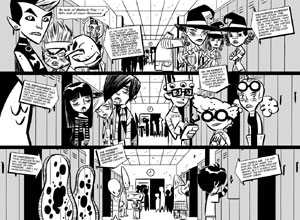
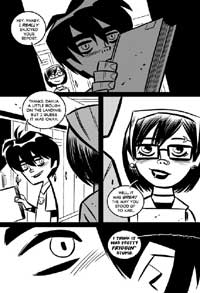 |
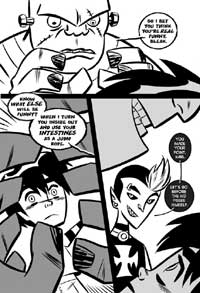 |
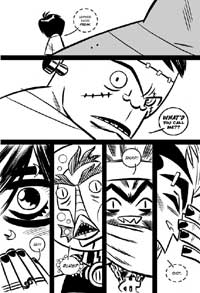 |
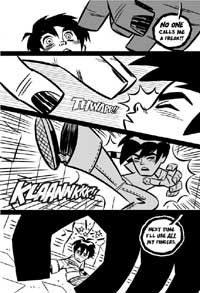 |
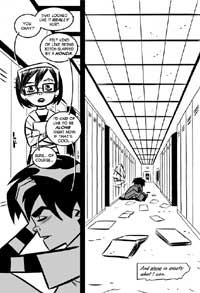 |
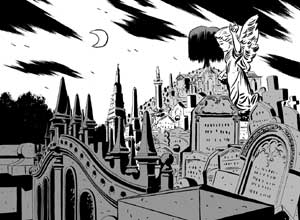
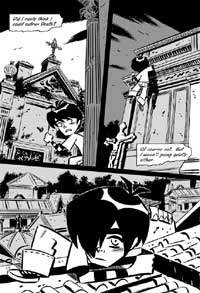 |
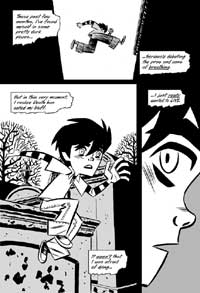 |
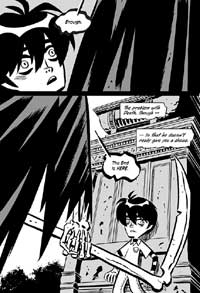 |
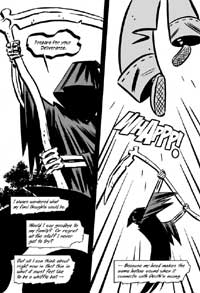 |
